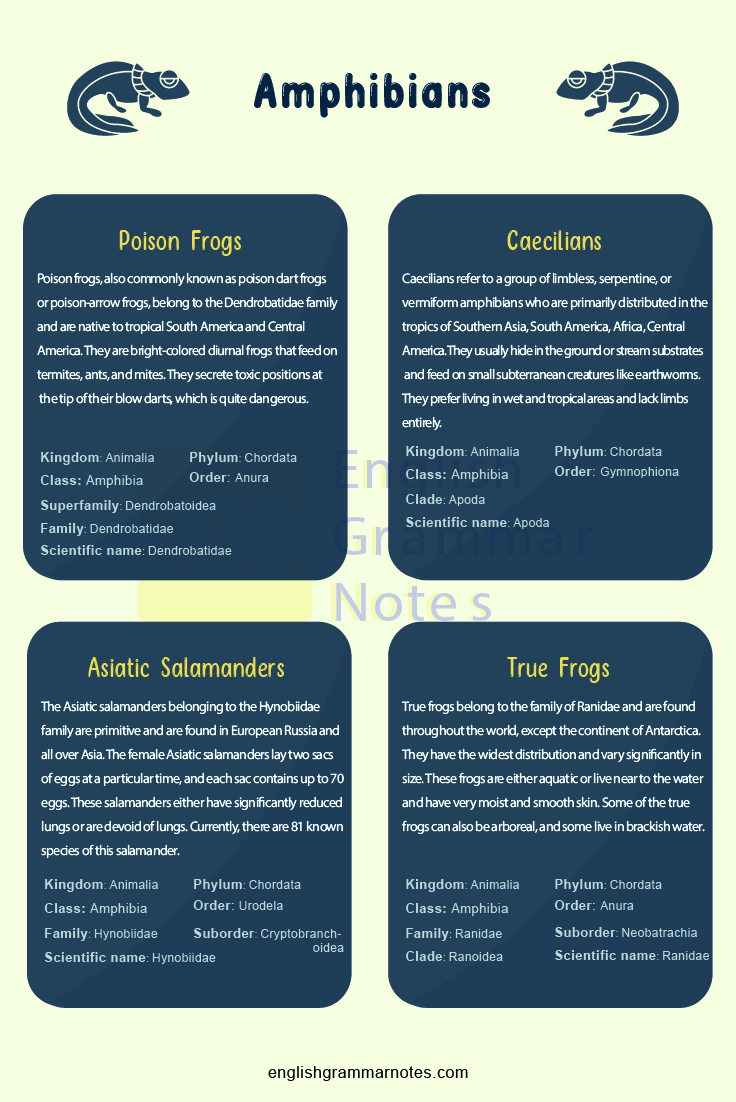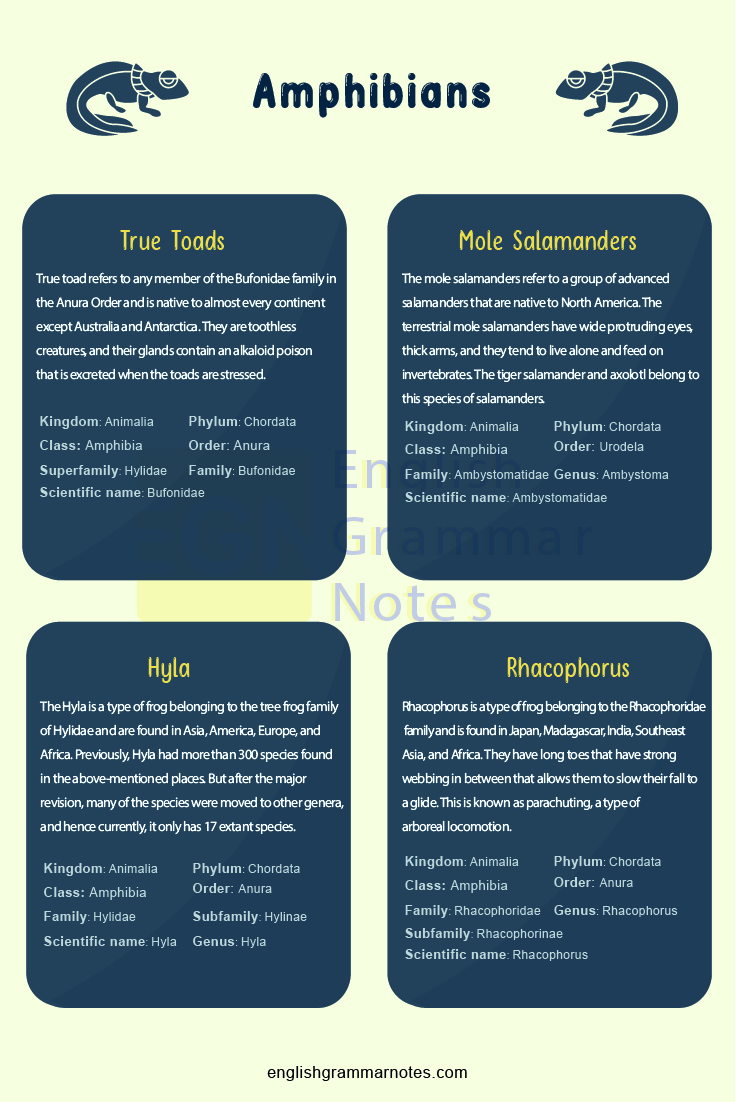Amphibians: Amphibians are four-limbed, ectothermic vertebrates that belong to the class of Amphibia. There are numerous species of amphibians living in the world, and each of them has different characteristics. Remembering the list of amphibians a-z can be tricky at times because each has different names and characteristics. A list of amphibians for your easy remembrance is given in this article. The list of amphibians with pictures will help you to identify a specific amphibian among other amphibians quickly.
Study the most important English Vocabulary Words identified by our experts and learn the right vocabulary to use in your day to day conversations
List of Amphibians
Name of Amphibians
- Giant Salamanders
- Tree Frogs
- Newts
- South Asian Frogs
- Mudpuppies
- Poison Frogs
- Caecilians
- Asiatic Salamanders
- True Frogs
- Pacific Giant Salamanders
- True Toads
- Mole Salamanders
- Sirens
- Hyla
- Racophorus
Description of the Amphibians given on the list
Giant Salamanders
The giant salamanders are a type of aquatic salamanders belonging to the family of Cryptobranchidae and are native to Japan, Eastern United States, and China. They are among one of the giant living amphibians and can reach a length of 4.7 ft. These salamanders are nocturnal, and they feed on crustaceans, fishes, shrimps, and frogs. They can live up to the age of 50 years in captivity.
| Kingdom | Animalia |
| Phylum | Chordata |
| Class | Amphibia |
| Order | Urodela |
| Suborder | Cryptobranchoidea |
| Family | Cryptobranchidae |
Tree Frogs
The tree frog is a type of frog that spends most of its life on trees, i.e., in an arboreal state. They are usually minimal and tiny since branches and twigs carry their weights. These frogs feed on insects and other vertebrates.
| Kingdom | Animalia |
| Phylum | Chordata |
| Order | Anura |
| Family | Hylidae |
| Scientific name | Hylidae |
Newts
Newts are semi-aquatic salamanders belonging to the Pleurodelinae subfamily and are found in Europe, North America, Asia, and North Africa. Since they are terrestrial, they spend half of the year living in water and the rest on land. Many species of the Newts are kept as pets, and some of them are listed as endangered species.
| Kingdom | Animalia |
| Phylum | Chordata |
| Class | Amphibia |
| Order | Urodela |
| Family | Salamandridae |
| Subfamily | Pleurodelinae |
| Scientific name | Pleurodelinae |
Mudpuppies
Mudpuppies, also known as Necturus or waterdogs, are aquatic salamanders endemic to the eastern United States and Canada. They have a robust body structure and prefer living in surface clear water with rocky substrates. The mudpuppies are nocturnal and feed on different prey, including crayfish.
| Kingdom | Animalia |
| Phylum | Chordata |
| Class | Amphibia |
| Order | Urodela |
| Family | Proteidae |
| Genus | Necturus |
| Scientific name | Necturus |

Poison Frogs
Poison frogs, also commonly known as poison dart frogs or poison-arrow frogs, belong to the Dendrobatidae family and are native to tropical South America and Central America. They are bright-colored diurnal frogs that feed on termites, ants, and mites. They secrete toxic positions at the tip of their blow darts, which is quite dangerous.
| Kingdom | Animalia |
| Phylum | Chordata |
| Class | Amphibia |
| Order | Anura |
| Superfamily | Dendrobatoidea |
| Family | Dendrobatidae |
| Scientific name | Dendrobatidae |
Caecilians
Caecilians refer to a group of limbless, serpentine, or vermiform amphibians who are primarily distributed in the tropics of Southern Asia, South America, Africa, Central America. They usually hide in the ground or stream substrates and feed on small subterranean creatures like earthworms. They prefer living in wet and tropical areas and lack limbs entirely.
| Kingdom | Animalia |
| Phylum | Chordata |
| Class | Amphibia |
| Order | Gymnophiona |
| Clade | Apoda |
| Scientific name | Apoda |
Asiatic Salamanders
The Asiatic salamanders belonging to the Hynobiidae family are primitive and are found in European Russia and all over Asia. The female Asiatic salamanders lay two sacs of eggs at a particular time, and each sac contains up to 70 eggs. These salamanders either have significantly reduced lungs or are devoid of lungs. Currently, there are 81 known species of this salamander.
| Kingdom | Animalia |
| Phylum | Chordata |
| Class | Amphibia |
| Order | Urodela |
| Suborder | Cryptobranchoidea |
| Family | Hynobiidae |
| Scientific name | Hynobiidae |
True Frogs
True frogs belong to the family of Ranidae and are found throughout the world, except the continent of Antarctica. They have the widest distribution and vary significantly in size. These frogs are either aquatic or live near to the water and have very moist and smooth skin. Some of the true frogs can also be arboreal, and some live in brackish water.
| Kingdom | Animalia |
| Phylum | Chordata |
| Class | Amphibia |
| Order | Anura |
| Suborder | Neobatrachia |
| Clade | Ranoidea |
| Family | Ranidae |
| Scientific name | Ranidae |

Pacific Giant Salamanders
The Pacific giant salamanders are large salamanders that belong to the Dicamptodon genus and are native to the Pacific Northwest in North America. They have protruding eyes, thick arms and are mostly silent, though some have vocal abilities. These salamanders are semi-aquatic and prefer to live in lakes and cold mountain streams.
| Kingdom | Animalia |
| Phylum | Chordata |
| Class | Amphibia |
| Order | Urodela |
| Family | Ambystomatidae |
| Genus | Dicamptodon |
| Scientific name | Dicamptodon |
True Toads
True toad refers to any member of the Bufonidae family in the Anura Order and is native to almost every continent except Australia and Antarctica. They are toothless creatures, and their glands contain an alkaloid poison that is excreted when the toads are stressed.
| Kingdom | Animalia |
| Phylum | Chordata |
| Class | Amphibia |
| Order | Anura |
| Superfamily | Hylidae |
| Family | Bufonidae |
| Scientific name | Bufonidae |
Mole Salamanders
The mole salamanders refer to a group of advanced salamanders that are native to North America. The terrestrial mole salamanders have wide protruding eyes, thick arms, and they tend to live alone and feed on invertebrates. The tiger salamander and axolotl belong to this species of salamanders.
| Kingdom | Animalia |
| Phylum | Chordata |
| Class | Amphibia |
| Order | Urodela |
| Family | Ambystomatidae |
| Genus | Ambystoma |
| Scientific name | Ambystomatidae |
Sirens
The sirens refer to a family of neotenic aquatic salamanders found only in Northern Mexico and the Southeastern United States. They have external gills and small forelimbs and are devoid of hind limbs. These salamanders are usually carnivorous, but there are instances where they have been found feeding on plant materials.
| Kingdom | Animalia |
| Phylum | Chordata |
| Class | Amphibia |
| Order | Urodela |
| Family | Sirenidae |
| Genus | Siren |
| Scientific name | Siren |
Hyla
The Hyla is a type of frog belonging to the tree frog family of Hylidae and are found in Asia, America, Europe, and Africa. Previously, Hyla had more than 300 species found in the above-mentioned places. But after the major revision, many of the species were moved to other genera, and hence currently, it only has 17 extant species.
| Kingdom | Animalia |
| Phylum | Chordata |
| Class | Amphibia |
| Order | Anura |
| Family | Hylidae |
| Subfamily | Hylinae |
| Genus | Hyla |
| Scientific name | Hyla |
Rhacophorus
Rhacophorus is a type of frog belonging to the Rhacophoridae family and is found in Japan, Madagascar, India, Southeast Asia, and Africa. They have long toes that have strong webbing in between that allows them to slow their fall to a glide. This is known as parachuting, a type of arboreal locomotion.
| Kingdom | Animalia |
| Phylum | Chordata |
| Class | Amphibia |
| Order | Anura |
| Family | Rhacophoridae |
| Subfamily | Rhacophorinae |
| Genus | Rhacophorus |
| Scientific name | Rhacophorus |
